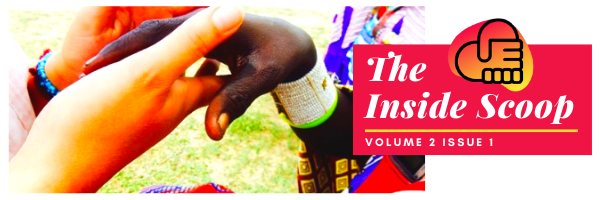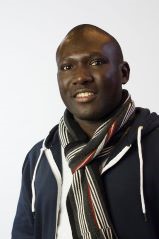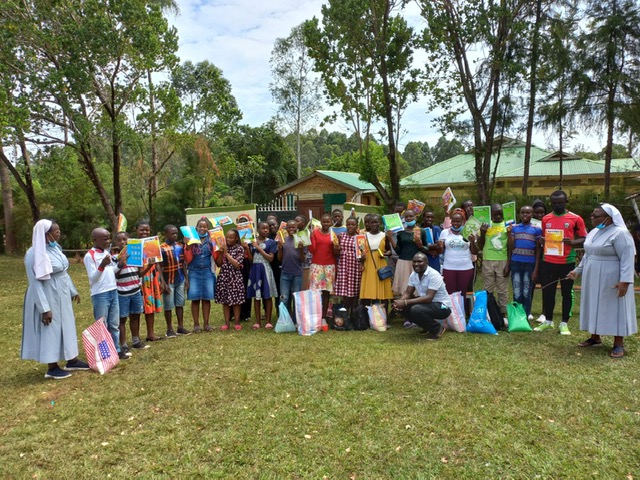
We can hardly wait to send out this Newsletter to you. In our December Newsletter we mentioned we were wanting to “Hatch the Hatchery” and asked if you could help. So many of you reached out with incredible generosity that with our matching funds we reached our goal and are moving forward with the Hatchery Project in Western Kenya. Sister Agnes and her consultant, P.S Lumumba, are so excited also.

Sister Agnes feeding kids 
PS Lumumba
It is with hearts full of gratitude that we thank all who are supporting us, energetically, financially and with time and expertise that we do not have. Our team are all volunteers pouring their hearts and souls into making a difference; having an impact on creating a new world. We were blessed with a man in California, Chuck Cunningham who developed an Excel spreadsheet extraordinaire so we can more easily track monies coming in, going out and the three projects. And PS Lumumba has been there as a consultant for Sister Agnes and met with us on Zoom recently to hear the good news and to educate us on how we will move forward now that funding for the Hatchery is assured . We are deeply grateful Sister Agnes has someone who knows the Hatchery business and is sharing his experience with her and with us and doing so much of the legwork! We hope you all can feel our gratitude! Moving forward here are some tidbits for you about how a commercial hatchery unfolds.
As you might recall, we needed money to purchase an incubator, a water tank that will catch rainwater and store water for when there are no rains, 5 months of feed, vaccines and medicine plus a feeding system to be sure all chicks get the proper amount of food and water. We also need funds to connect to electricity and plumbing for the water. We also saved up enough money for the purchase of a used vehicle. Here is how we are proceeding. The purchase the vehicle needs to be first as deliveries will start 3 weeks after the eggs are put in the incubator. So P S Lumumba and Sister Agnes will travel to Mombasa Kenya. Mombasa is a coastal city in southeastern Kenya along the Indian Ocean. The city is known as the white and blue city in Kenya. It is the country’s oldest and second-largest city, with a population of about 1,208,333 people according to the 2019 census.

The children under Sister Agnes’s home and feed program will be brought into the Hatchery Business from the start so they can see how and why things are set up the way they are. We will be meeting with Sister Agnes and her team to hear about the plans for including the children in learning about the development of the Hatchery Business. Since Mombasa is a port city, the large cargo ships dock there bringing in everything, including used cars from markets like Japan. Our project needs a sturdy vehicle with high clearance for the rutted roads in rainy weather in Kakamaga, Kenya which is almost as far west as you can go in Kenya before entering into Uganda and about 800 km from Mombasa. (Sr Agnes is in Kakamega in Western Kenya -376 km from Nairobi. (52 km from Kisumu). Mr. Lumumba works for the Kenyan State Department of Planning as an urban planner in Nairobi and he will utilize the knowledge and resources of friends who are familiar with the process of going to the port to purchase a vehicle. He will negotiate the price, have a mechanical evaluation and help Sister Agnes with all the details of purchasing the vehicle, insurance and perhaps arranging for a mechanic to raise the vehicle for road clearance if it is riding too low. Because the trip is so long, an overnight stay will be needed.
Workers will be hired in Kakamega to install plumbing and wiring for electricity in the hatchery. The rest of the needed supplies will be purchased in Nairobi. Supplies will likely be ordered and brought home by Mr Lumumba and installed in the Poultry shed. We think we need to re-name the poultry “shed” as a fine looking two story building like that should have a more elegant name!
500 eggs will be purchased and 21 days later we expect 500 chicks. The plans are to sell about half the chicks. Some in the community want to purchase day old, some week old, some month – old chicks for raising on their own. The rest of the chicks will be raised to become “layers” or “broilers” and of course most of the broilers will go to market to be sold. They have already been developing the market contacting hotels and schools. As they move forward they will time the business as much as possible to have larger amounts of product around holidays and festivals as that is a time of high demand. On average layers are very productive for about 2 years and then production goes down so new layers will be hatched and kept to assure a constant rotation. It takes about 5 to 6 months for the layers to start laying eggs.
The children under Sister Agnes’s home and feed program will be brought into the Hatchery Business from the start so they can see how and why things are set up the way they are. We will be meeting with Sister Agnes and her team to hear about the plans for including the children in learning about the development of the Hatchery Business.

Despite all the losses Mama Charity has experienced, she is carrying on, saying she needs to do twice as much since her daughter, Manuela Wisdom who recently died, had her own dreams for the community. The agribusiness is off to a running start with the beans, cassava and sweet potato growing quickly. In the spring she will be prioritizing her time between the farm, the primary school in Ghana that she built and is overseeing and of course the orphanage which now has 115 children
Our energies now will be to find partners in Africa to get water in Mama Dinah’s community. Because of the drought and the rainy season still a few months away, all the livestock, cows and goats have been moved where there is at least some food and water supply. Some livestock have died and some in the community are moving away in an effort to find water. We will also be exploring a company in Africa that has developed a rolling tank to transport water so the mama’s can transport water without 25 liters on their backs. Another company has developed special clay water filters and we would like to get more information. The biggest challenge of course is to get the best information from local sources on the success of finding underground water in the area and securing the finances for a reputable firm to drill a new borehole.
In our next Newsletter around the beginning of February we hope to have photos and a report on progress on the Hatchery in Kenya. Right now we are arranging for the money needed to be wired to them so they can start doing the wiring and plumbing for electric and water connections in that elegant two story hatchery!
